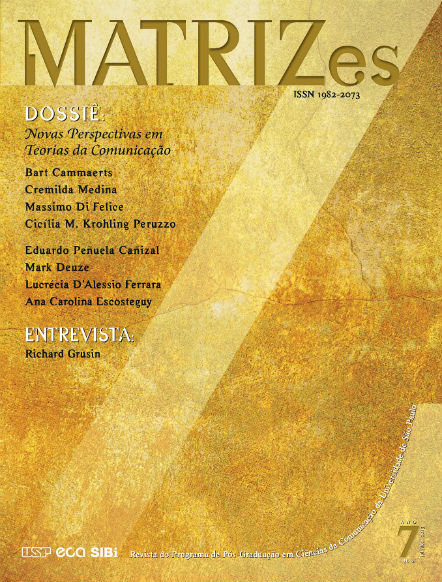From remediation to premediation: or how the affective immediacy of late 90’s digital society evolves to an continuous affectivity anticipation of future in the 21th century
DOI:
https://doi.org/10.11606/issn.1982-8160.v7i2p163-172Abstract
Richard Grusin one of the most well known on media studies researchers and a pioneer on this area. His work concerns historical, theoretical, and aesthetic aspects of media technologies. With Jay David Bolter he is the author of Remediation: Understanding New Meda (MIT, 1999), which sketches out a genealogy of new media, beginning with the contradictory visual logics underlying contemporary digital media; Remediation has a remarkable connection with his fourth book, Premediation: Affect and Mediality After 9/11 (Palgrave, 2010), which argues that in an era of heightened securitization, socially networked US and global media work to pre-mediate collective affects of anticipation and connectivity, while also perpetuating low levels of apprehension or fear. The richness of his analysis is the connection between our daily and real life to the digital ambiances that underlies our society. Richard Grusin had recently visited many Brazilian Universities and research groups for a series of conferences and master classes focusing on the dark side of the digital humanities, and also the discussion on premediation social state-of-life.Downloads
Download data is not yet available.
Downloads
Published
2013-12-06
Issue
Section
Interview
License
Authors who publish in this journal agree to the following terms:
- Authors retain the copyright and grant the journal the right to first publication, with the work simultaneously licensed under the Creative Commons Attribution License (CC BY-NC-SA 4.0) which allows sharing of the work with acknowledgment of authorship and initial publication in this journal for non-commercial purposes.
- Authors are authorized to assume additional contracts separately, for non-exclusive distribution of the version of the work published in this journal (eg, publishing in institutional repository or as a book chapter), with acknowledgment of authorship and initial publication in this journal.
How to Cite
Saad Correa, E. (2013). From remediation to premediation: or how the affective immediacy of late 90’s digital society evolves to an continuous affectivity anticipation of future in the 21th century. MATRIZes, 7(2), 163-172. https://doi.org/10.11606/issn.1982-8160.v7i2p163-172






















